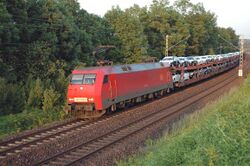Engineering:Unit train
A unit train, also called a block train or a trainload service, is a train in which all cars (wagons) carry the same commodity and are shipped from the same origin to the same destination, without being split up or stored en route.[1] They are distinct from wagonload trains, which comprise differing numbers of cars for various customers.[2]
Unit trains enable railways to compete more effectively with road and internal waterway transport systems. Time and money is saved by avoiding the complexities and delays that would otherwise be involved with assembling and disassembling trains at rail yards near the origin and destination. Unit trains are particularly efficient and economical for high-volume commodities. Since they often carry only one commodity, cars are of all the same type; often the cars are identical.
Use
Unit trains are typically used for the transportation of bulk goods. These can be solid substances such as:
- Track ballast or gravel
- Iron ore from mines to ports or steel mills
- Coal from mines to power stations
- Coke from coking plants to steel mills
- Phosphate from mines to fertilizer plants
- Ore
- Steel
- Potash
- Taconite
- Aggregate
- Sand for hydraulic fracturing[3]
Bulk liquids are transported in unit trains made up of tank cars, such as:
- Crude oil from oil fields to refineries (can be [60,000 barrels (9,500 m3)] of oil in a unit train of 100 tank cars)[4]
- Mineral oil products from the refineries to the storage facilities
- Ethanol from ethanol plants to motor fuel blending facilities[5]
- Molten sulfur (non-US:sulphur)
Food, such as:
Other examples include:
- Intermodal containers, generally between a port and a truck depot
- Cars in autoracks
- Military Equipment (weapons)
- Waste (garbage), usually for recycling, often metals or paper
- TOFC
See also
- Drag freight, a type of unit train.
- Coke Express
- Merry-go-round train
- Railex
- Tropicana's Juice Train
References
- ↑ "Unit train". Encyclopædia Britannica. 2014. http://www.britannica.com/EBchecked/topic/615316/unit-train.
- ↑ Oliver Wyman. "The Mixed Train Concept: The Best of Both Worlds for European Rail Freight?". http://www.oliverwyman.com/media/WP07-MTE_RR-Wagonload-A4.pdf. "...trainload service (point to point, complete train for one customer) or wagonload service (single wagons for various customers, assembled into trains)"
- ↑ Cook, Pete (December 1, 2015). "Insights into the Largest Frac Sand Unit Train on Record". http://www.petroleumconnection.com/blog/insights-into-the-largest-frac-sand-unit-train-on-record.
- ↑ McGurty, Janet; Adler, Lynn; Gregorio, David (2011-07-22). "Union Pacific sees rail oil shipments quadrupling". Reuters. https://www.reuters.com/article/usrail-oilshipments-idUSN1E76L18M20110722.
- ↑ Thompson, Stephen (September 2006). "Keep on Truckin’: Ethanol boom creates transportation challenges". United States Department of Agriculture. http://www.rurdev.usda.gov/rbs/pub/sep06/keep.htm.
 |


